Raleigh, NC: (919) 277-9299

In the legal world, damages for auto accidents are typically calculated by combining economic damages, non-economic damages, and (less often) punitive damages. No single universal formula applies to calculating damages for all crashes, as the law and the unique facts behind each case dictate legal outcomes.
Assessing the Impacts of Car Accidents
Each year, millions of Americans are involved in car accidents that can have long-term financial and emotional consequences—especially for those who are injured.
For many individuals affected by car crashes, though, how to put a dollar amount on the damages is a mystery.
The 3 Primary Types of Auto Accident Damages
Here’s a brief rundown of the three types of personal injury damages used to quantify the harm a claimant has experienced as a result of an auto accident:
1. Economic Damages (aka Special Damages)
Special damages in a personal injury case, the most tangible of the three types of damages, are the monetary losses incurred in an auto accident. They include:
- Medical expenses, including the costs of emergency care, surgical procedures, medications, and therapy services directly attributed to the accident
- Loss of income due to missed work during recovery from injuries experienced in the accident, as well as any reduced earning capacity caused by long-term or permanent injuries
- Property damage, including repair and/or replacement costs for vehicles and any other property damage resulting from the accident
2. Non-Economic Damages
These personal injury damages include more subjective harm caused by an auto accident, such as pain and suffering. An attorney sometimes implements a multiplier factor to determine the amount of non-economic damages awarded. There is no standard multiplier used to calculate non-economic damages. The factor may also increase based on the severity of a claimant’s injuries and their impact on his or her quality of life.
3. Punitive Damages
In cases of extreme negligence, a judge or jury may decide to award punitive damages.
Next Steps After a Crash: Gathering Evidence of Damages
Taking the right steps in the wake of an accident can help you build a stronger case should you decide to pursue legal action to recover damages. Important evidence to collect after a crash includes:
- Photos and videos from the accident scene
- Records of any medical expenses incurred as a result of the crash
- Photos of physical injuries sustained in the crash
- Pay stubs showing any loss of income caused by the accident and recovery from injuries
- Copies of any bills incurred as a result of the accident
- Estimates for repairing vehicle damages caused by the crash
- A personal injury journal detailing the physical and emotional effects of the accident and the injuries it caused
Partial Fault Rules: Contributory vs. Comparative Negligence
Partial fault for a car crash can limit the damages an individual may seek in an auto accident lawsuit. In some states and jurisdictions—including North Carolina —contributory negligence applies. Under this doctrine, if a claimant’s own negligence is determined to have contributed to the accident in any way, he or she is not allowed to recover damages from the primary at-fault party. (In most other states, comparative negligence applies.) Depending upon the state laws that apply to your case these legal doctrines may or may not apply.
If you’ve suffered an injury as the result of a car accident, an auto accident lawyer can help you with many aspects related to any personal injury lawsuit you may choose to pursue, including:
- Science-based crash investigation
- Recreating your accident with the help of a team of engineers
- Discussions with insurance companies
- Calculating auto accident damages
- Filing and overseeing your personal injury claim
Contact us today—Bell Legal’s auto accident lawyers want to hear your story. We’ll provide the legal guidance and personal injury law insights you need to pursue your legal goals.
